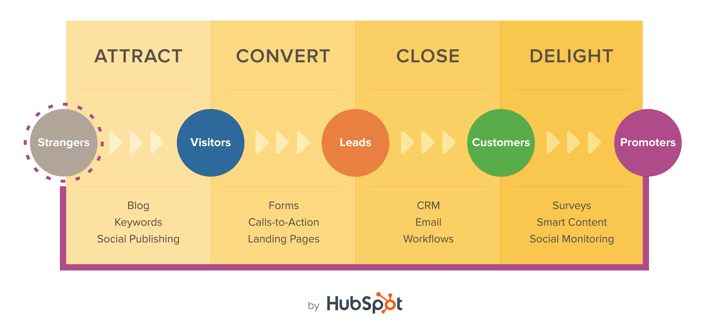Inbound Marketing: Getting Started
In today’s digital age, “traditional” methods of marketing, like direct mail and cold calls, have become null and void. And as competition in the marketplace gets more savvy, it’s not enough to just sit around and wait for business to grow. Thankfully, more direct efforts (ahem… “inbound marketing”), allow businesses to target the customers they actually want and need – and as a result, be proactive about their own success.
First, evaluate your current plan.
Before you come up with an effective strategy for your inbound marketing, it’s important to analyze your company’s current sales and marketing efforts to find out what you need to do to reach your company goals. Instead of focusing on meaningless marketing metrics like the number of page visitors, clicks, or followers, look instead at how those numbers developed. What traffic is your website attracting, and how much of that traffic is being converted into leads? Once you answer these questions, you can start to figure out how to reach your ultimate goal: turning those leads into actual (paying) customers.
Website Traffic: While high numbers of visitors are important, what’s more important is how many of those visitors matter for your business. Find out who they are by learning more about them (are they organic users or paid followers?) and where they come from – like whether they’re referrals from other websites or from social channels, email blasts, direct mailings, or any other source of marketing.
Leads: When traffic turns into a lead, it means a visitor took an action you wanted him or her to take; even if it’s as simple as reaching out with a question. Determine how good you are at turning traffic into leads by dividing the total number of conversions by the number of visitors to your site. (For example, if you have 1000 users and 10 conversions, divide 10 by 1000 to get a conversion rate of 1%.) The higher the conversion rate, the more leads you’re acquiring; and the closer you are to getting more customers.
Customers: Look at your customer base. Evaluate how much you spend on customers, the value of their sales and how often your customers make repeat purchases to find out just how good your company is at growing business.

Decide whether to attract, convert, close or delight.
Once you know what you’re dealing with, be strategic about how you go about inbound marketing.
Attract: If you know who your traffic is and where they come from, you can target them appropriately by sending them the right content. Blogging and social media is key here, as well as optimized keywords and web pages.
Convert: Once you’ve attracted web traffic, it’s time to create a “call to action” to turn them into real business leads. Landing pages are a great way to get visitors to give up personal contact information, typically in exchange for information they want – like a webinar or company information. Keep your offers unique, valuable and informative to gain their interest and convert the visitor into a lead.
Close: “Closing” a lead (or turning them into a customer) is the longest part of the process, and can take from 7 and 13 touches to convert a lead to a sale. Prioritize your leads and use a series of emails to bring them through the sales process. Relationship building, or keeping in regular contact, is key to closing the final sale.
Delight: Just because a sale has been made, doesn’t mean the duty to the customer has ended. Post sale, it’s time to nurture the customer. You’ll want to use social media channels and emails to keep engaging with the customer, assure them they made the right choice in working with you, and send them appropriate content. Delighting the customer is the best way to keep them coming back for more.

Realize “the cost of inaction.”
Making a solid investment in your company’s future is always scary. Fortunately, inbound marketing gives us a direct and cost-efficient way to target customers you want to grow your business – making not doing anything, what experts call “the cost of inaction,” a much bigger risk. If you considered making a change to grow business in the first place, there was obviously a reason for it. What goals were you not reaching? What do you need to be able to reach them? And if you’re considering these tactics, you can probably assume that your competitors are, too. The cost of inaction, therefore, is a combination of cost, business risk and consequence. Are you prepared to sit back and let your competition take the lead?
Now, let’s talk money.
While we’ve only touched on the surface of what inbound marketing is capable of, it’s important to consider the cost. In today’s business landscape, it’s no surprise that to make money, you have to spend money – but that doesn’t mean you have to break the bank. Thanks to recent research, we know that inbound marketing is not only the best (and most relevant) way to grow your business, but since it costs 60% less per lead than outbound marketing, it also gives you the best bang for your buck, and the percentages match. To grow business, experts believe that companies generating less than $5M in annual revenue need only spend 7 to 8 percent on their entire marketing budget, with inbound marketing taking up the bulk; and the more you bring in, the lower those percentages go.
As any businessperson knows, success is always a game of numbers. But when it comes to inbound marketing, one thing’s for sure: The numbers are always in your favor.



![Reignite Your Millennial Marketing Efforts With These [On Fleek] Ideas](https://blog.gorizen.com/hs-fs/hubfs/Podcast/009%20-%20Millennial%20Marketing%20Blog.gif?length=600&name=009%20-%20Millennial%20Marketing%20Blog.gif)


No Comments Yet
Let us know what you think